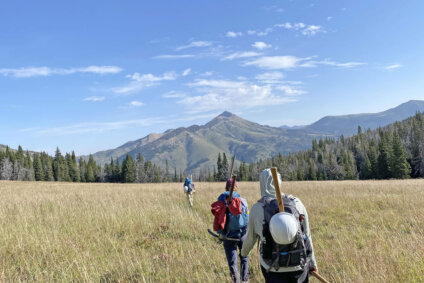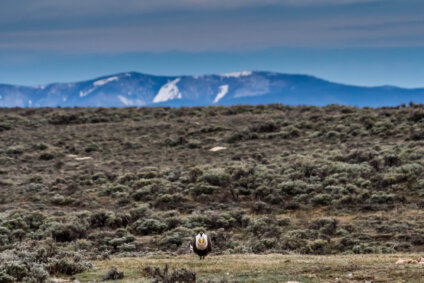What’s in a Tradition?
How community takes root and grows in Montana's wild places

By Al Kesselheim
Twenty years ago, I met a group of longtime friends at the Storm Lake trailhead for a week of hiking in the Anaconda-Pintler Wilderness. A quirky suggestion brought us together. What if at the start of every decade, beginning in our 50s, whoever had a birthday that year would propose an adventure, and everyone would show up ready to go? As the group elder, I got to go first, and true to form, everyone wheeled up by the deadline. College friends, professional colleagues, couples with kids who grew up together – all of us had known each other for decades, but sometimes years passed without contact. They came from as far away as Oregon, Colorado, and Alaska.
That week, we crisscrossed the mountainous spine, camping at lakes, climbing West Goat Peak, up and over rugged passes, and along valleys. We had yoga sessions in the morning, game nights in camp, hilarious interludes of food hanging, skinny dips, storms, and glorious alpine vistas. More importantly, we embraced each other’s company, reinforced friendships, caught up on life, and shared triumphs and tragedies.
We are now heading into the decade of our 70s. Our lives keep evolving, but the tradition lives on. Through our 50s and 60s, trips have wandered all over the country’s western half and into Canada. But the foundational journey that kicked it off began in the company of Montana wildflowers, alpine lakes, looming peaks, and the Continental Divide. Some of our children have picked up the thread, beginning in their late 20s. This thing could span a century or more if we keep at it.

Traditions are like that. We all have them. Special holiday ceremonies, yearly family reunions, friends who rent the same backcountry cabin every summer, celebrations of everything from coming-of-age to retirement to seasons. We do them to remind ourselves of what is essential in life – the big things, like family, friendship, and nature, and the moments when we shed everyday complications in favor of the stuff that matters. The things we might actually remember at the end.
What’s freeing about the business of traditions is that there are no rules. And the wild places in southwest Montana are right up there when it comes to worthy settings to stage them. It can be a one-off or last a lifetime. It can be solitary or with a group. Whatever it is, call it a tradition. No one will question it. Once it begins, traditions have a way of perpetuating themselves. An inertia builds up; you don’t want to break the string, so expectations take hold.
A few years back, over Memorial Day weekend, I celebrated another adventurous tradition that is a decade old. I sat around a fire at the campground on upper Flint Creek, near Georgetown Lake, with 22 companions celebrating what we call the Three Rivers weekend. The group age runs the gamut from Social Security recipients to 20-somethings, men and women, doctors, artists, lawyers, contractors, teachers, and counselors. Mostly Montanans, but a few outliers from as far away as Washington and Arizona. Some of us only see each other this one weekend every year. The common thread is a love for rivers and paddling.
Again, an out-of-the-blue suggestion kicked the whole thing off. What if a bunch of us who enjoy rivers got together every Memorial Day to take on three ephemeral Montana streams over the three-day weekend? While some of these destinations are well known, most are not flows you’ll find in guidebooks. They typically only run high enough to float for a few weeks every spring, sometimes not even then. They are runs that qualify on the “gnar” scale, with the potential for log jams, fences, low bridges, and beaver dams – rivers where you edge around every corner, ready for an ambush. Think of streams like Grasshopper Creek downstream of Bannack, Silver Bow Creek through Durant Canyon, and the Mill/Willow bypass along Warm Springs Ponds. That year’s floats featured stretches of upper Rock Creek, the headwaters of the Clark Fork, and the Little Blackfoot.
In another southwest Montana iteration of tradition, my brother-in-law in Dillon took on a string of monthly ski outings that morphed into a quest that lasted more than a decade. He found a patch of snow large enough to link a dozen consecutive telemark turns every month of every year. No big deal from November to June most years, but decidedly tricky come August. He ran all over Beaverhead County in search of a reasonable snowfield, sometimes making heroic hikes carrying ski gear to schuss down a tight bit of fading snowdrift. Hell, he might still be doing it if he hadn’t fallen off a ladder and suffered some tradition-ending injuries.
As a family, we celebrated every winter solstice by renting a Forest Service cabin, lighting candles on the porch, and howling at the moon. When the kids were tiny, we picked cabins you could drive to. Later, we skied in. We enjoyed Hell Roaring Cabin above the Jefferson River, the comparative luxury of the West Fork of Rock Creek Cabin, and Beaver Creek Cabin near Quake Lake. We still rent a cabin every December, even now that the kids are out of the house. Sometimes it’s just the two of us. Sometimes everyone shows up.
Back at the fire ring along Flint Creek, we held a brief logistical meeting about the next day’s float, but the main order of business was to visit with each other, catch up, share stories, and pick up friendships where they left off. That went on until dark, when the coals glowed red, and people wandered off to bed, anticipating the mysterious contours of the morning’s river saga.
Al Kesselheim is an author, Butte resident, and lover of Montana’s land and waters. This essay was originally published in Wild Montana’s quarterly newsletter.
Stay Connected
"(Required)" indicates required fields


